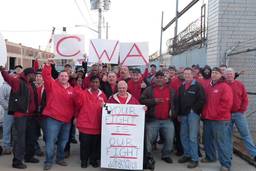If you scan the resumes of corporate executives on LinkedIn, you can identify who has attended General Electric’s union avoidance courses. GE’s Union Avoidance Department, headed by Mark Guthrie, is known to be one of the most effective anti-labor departments in American. Unions almost never win elections at the company.
So it’s surprising that a group of workers at GE Transportation in Kansas City, Mo., recently voted 44-41 to join IBEW Local 1464. It was the first time that a union had organized a GE bargaining unit in 10 years; the last was a small service shop in Florida containing a dozen workers. According to the IBEW, it was the first time anyone has organized a large-scale GE facility in 20 years.
The key to this success seems to be workers’ perseverance. Despite three previous failed attempts in four years to organize the plant, workers strategically countered the talking points of GE’s anti-union campaign. In 2010, workers at the Kansas City plant attempted to organize a union with IBEW after seeing a worker die on the job in a horrific accident. But in a December 2010 election, pro-union workers lost by a mere 11 votes.
During the anti-union campaign of the 2010 election, GE promised workers that wages would increase significantly if they voted down the union. According to IBEW Local 1464 Lead Organizer Mike Knox, when the wage increase failed to happen as expected, many workers began to feel that the only way to improve wages was to unionize.
In response to the union drive, GE rolled out an intense anti-union drive, including captive audience meetings and one-on-one meetings between workers considering a union and their supervisors.
“The Volunteer Organizing Committee was very active. The company identified very quickly who were the union pushers and kept them separated from others workers,” says IBEW Local 1464 Business Manager Darrell McCubbins. “They were keeping them separated on overtime and shifts so that the younger second shift couldn’t talk to the older first shift.”
Through the Voluntary Organizing Committee, however, workers were able to maintain active communications between older more pro-union workers on the first shift and younger more sacred workers on the second shift.
“I attended meetings with the daylight crew and some VOC members on daylight shift attended meetings with us,” says Jim Wasserman, a repairman who worked on the second shift. “We came to the same conclusion: that GE hadn’t convinced us about what they were going to do to answer our problems.”
One of the biggest myths the Volunteer Organizing Committee had to dispel was that GE would close the plants if workers voted to unionize. According to Knox, the committee argued to wary workers that GE in recent years had invested very heavily in the plant and was thus unlikely to close it.
“A very effective campaign of hand billing was a key thing to our victory. We were able to use handbills to go down and counter point by point every inaccurate statement that company made about the union,” says Knox. “Also, bringing in a worker from an IBEW-represented GE railroad plant also helped workers understand how the union would work for them. It was really important to have another GE worker there, especially an IBEW member who could speak their language.”
As a result of the efforts by IBEW Local 1464 and the Volunteer Organizing Committee, pro-union workers won the election by a slim margin of 44-41 in late January. But workers still have to fight to get GE to agree to a first contract; many companies refuse to agree to a first contract and instead push for decertification after one year.
“The workforce is still divided, and management is doing a good job of continuing to stir that up,” says IBEW Business Manager Darrell McCubbins.
On Friday, another group of GE workers — 150 people at a facility in Burlington, Iowa— filed for a union election to be represented by IUE-CWA. According to IUE-CWA organizer Jim Latcher, workers at that facility who had previously tried to unionize unsuccessfully are upset by a 30 percent wage cut imposed on workers.







